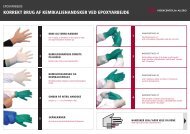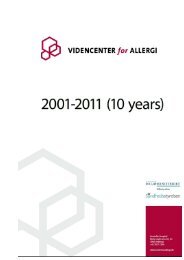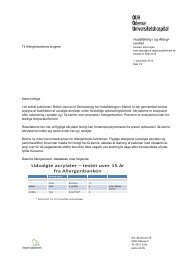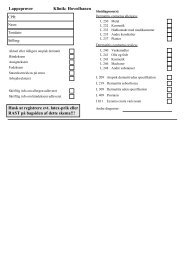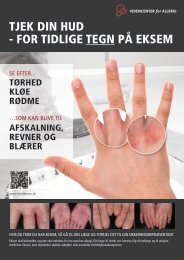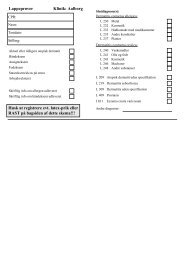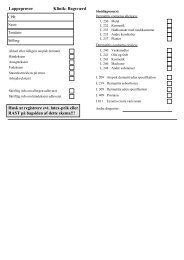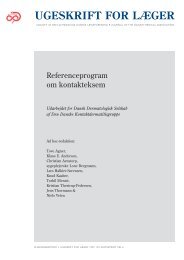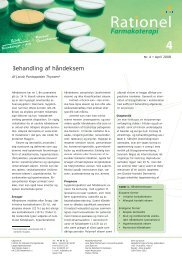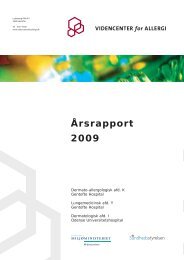Charlotte Devantier Jensen.pmd - Videncenter for Allergi
Charlotte Devantier Jensen.pmd - Videncenter for Allergi
Charlotte Devantier Jensen.pmd - Videncenter for Allergi
You also want an ePaper? Increase the reach of your titles
YUMPU automatically turns print PDFs into web optimized ePapers that Google loves.
and/or stronger dermatitis at the location of the <strong>for</strong>merly positive<br />
MDBGN-patch on both arms (see Fig. 18). In 1 patient, a<br />
moderate dermatitis developed on the entire test site without<br />
an augmented development at the areas with previous<br />
MDBGN-dermatitis. No increased response was seen at the<br />
patch test area with previous irritant dermatitis. The dermatitis<br />
on the MDBGN pre-treated areas appeared stronger on one of<br />
the arms in 7 of the subjects with an augmented response. In 6<br />
of these, this concurred with the arm previously patch tested<br />
with the high concentration of MDBGN, thus the stronger the<br />
previous patch test reaction to MDBGN, the stronger the response<br />
at challenge. A correlation between the strength of previous<br />
dermatitis and the intensity of flare-up reactions on oral<br />
challenge has been described 87 . In the control group all use<br />
tests were negative.<br />
Skin areas that one month prior had an inflammatory reaction<br />
to MDBGN-exposure, exhibited enhanced re-exposure<br />
reactions to both patch tests and use tests with a rinse-off product<br />
containing MDBGN. According to our knowledge, this is<br />
the first time that challenge of previously inflamed skin is per<strong>for</strong>med<br />
with a rinse-off product in a use test. Pre-irritated skin<br />
did not exhibit an augmented response to allergen exposure,<br />
thus the increased sensitivity to MDBGN seems to be specific<br />
to allergic eczema. These findings document the necessity <strong>for</strong><br />
careful avoidance of exposure to MDBGN-containing household<br />
and cosmetic products in patients previously sensitized.<br />
Our results are in agreement with the findings of Hindsén et<br />
al who per<strong>for</strong>med a series of important studies investigating<br />
the significance of previous dermatitis <strong>for</strong> the allergic response<br />
to nickel exposure 19,87,91 . They observed an increased reactivity<br />
similar to our results when previous nickel-eczema sites<br />
were challenged with nickel. Moreover, these studies examined<br />
the response to nickel exposure of skin with prior eczema<br />
elicited by an allergen other than nickel. They found that skin<br />
with prior cobalt-eczema had a response to nickel comparable<br />
to non-pre-treated skin 91 . Also, in oral challenge studies, it has<br />
been observed that flare-up reactions were localized to sites of<br />
previous dermatitis caused by the challenging allergen only 92,93 .<br />
In guinea pig studies, similar results have been observed as<br />
increased re-test reactivity to HEMA was only observed at<br />
<strong>for</strong>mer HEMA-skin test sites and not at previous DNCB-test<br />
sites, while likewise <strong>for</strong> DNCB re-test hyperreactivity was only<br />
found at <strong>for</strong>mer DNCB-test locations and not at previous<br />
HEMA-test sites 88 . Also, in these studies, sites of previous<br />
HEMA-dermatitis were re-tested with the irritant croton oil<br />
without resulting in hyperreactivity. These findings, together<br />
with the lack of persisting hyperreactivity of pre-irritated skin<br />
on allergen exposure, indicate that the enhanced response of<br />
earlier eczematous skin is an allergen-specific immunological<br />
phenomenon. It cannot be explained by increased penetration<br />
and bioavailability due to a compromised skin barrier, instead<br />
it seems likely that an immunological local memory function<br />
is responsible. Experiments have shown that hapten-specific<br />
T lymphocytes may persist <strong>for</strong> several weeks at <strong>for</strong>mer inflammatory<br />
sites, and probably cause local hyperreactivity at chal-<br />
Contact allergy to the preservative methyldibromoglutaronitrile 23<br />
Table 9. Results of use test challenge with an MDBGN-containing<br />
soap on test areas on the arms previously patch tested with MDBGN.<br />
Subjects Controls<br />
Positive use test 9 0<br />
(Augmented response 8)<br />
Doubtful use test 2 0<br />
Negative use test 6 10<br />
lenge with hapten 89,94 . Moreover, it has recently been shown<br />
that expression of the homing chemokine CCL27 and the<br />
receptor chemokine CCR10 remains increased 3 weeks after<br />
inflammation, while neither could be detected in normal or<br />
previously irritated skin after 3 weeks. As CCL27 is involved<br />
in the recruitment of T lymphocytes during an allergic reaction<br />
it is speculated that CCL27 might also play a part in retaining<br />
CCR10+ T cells at the previously exposed area of skin 94 .<br />
Skin irritated with 1% SLS 1 month be<strong>for</strong>e re-exposure did<br />
not exhibit an enhanced response to the use test. Hyporeactivity<br />
to exposure from nickel on pre-irritated skin has been demonstrated<br />
after 1 month while after 6-30 hours an augmented response<br />
was seen 91,95 . When challenged with an irritant, both<br />
hyper- and hyporeactivity have been described on previously<br />
irritated skin 95-99 . The reactivity is possibly dependent on the<br />
time period allowed between treatments as, generally,<br />
hyperreactivity has been described when re-test was per<strong>for</strong>med<br />
up to 2-3 weeks after first treatment and hyporeactivity has<br />
been described <strong>for</strong> re-test after 2 weeks or more. The increased<br />
reactivity succeeding the development of irritant dermatitis may<br />
partly be due to an enhanced penetration because of a damaged<br />
skin barrier, but probably also arises from induction of<br />
immunological mechanisms like expression of cytokines or<br />
increased density of Langerhans cells from the previous irritant<br />
reaction 100 . The following hyporeactivity has been hypothesized<br />
to occur because of other mechanisms as <strong>for</strong> instance<br />
thickening of the skin from hyperkeratosis and/or changes in<br />
the composition of strateum corneum lipids 97,101 .<br />
The results from this study could constitute the basis <strong>for</strong> the<br />
development of a standardized model <strong>for</strong> evaluation of rinseoff<br />
products, <strong>for</strong> instance to be used to compare the effects of<br />
different product <strong>for</strong>mulations. Exposure from rinse-off products<br />
may be difficult to predict, as the products are washed off<br />
the skin and they contain irritant ingredients that may produce<br />
unpredictable combination effects with allergens 22 . Also, longtime<br />
exposure is often necessary to observe the effects of the<br />
products because of a limited exposure. Alternatively, the augmented<br />
response of pre-treated skin in a use test, as observed<br />
here, may be exploited in this regard.<br />
Experimental studies have shown that previously eczematous<br />
skin, although appearing healed, may be susceptible to certain<br />
exposures <strong>for</strong> several months. This is important in<strong>for</strong>mation<br />
to patients suffering from dermatitis and enables them to take<br />
the best possible precautions.<br />
Forum <strong>for</strong> Nord Derm Ven Vol. 10, 2005 – Suppl. 8




